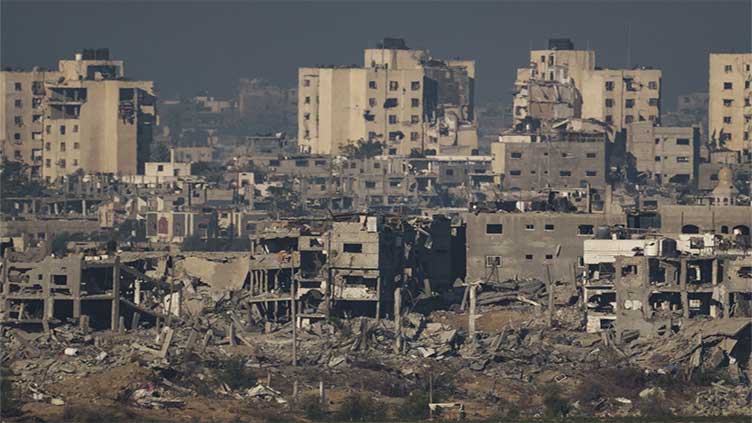Israel deepens its operation in Gaza City in pursuit of militants. Thousands flee again

World
Israel deepens its operation in Gaza City in pursuit of militants. Thousands flee again
DEIR AL-BALAH, Gaza Strip (AP) — Israeli forces deepened an operation in the Gaza Strip’s largest city in what the military said was meant to weed out militants, sending thousands of Palestinians fleeing on Monday from an area already ravaged in the early weeks of the nine-month-long war.
The incursion into eastern Gaza City expands Israel’s engagement in the beleaguered territory’s north, an area Israel said it had seized control of months ago. Pockets of militant resurgence have scaled back Israeli military gains and drawn forces back into such operations. Israel had ordered evacuations in the area before the raid, the military said.
Heavy fighting in the war’s first weeks all but emptied Gaza City and its environs, and the Israeli military has prevented most people from returning to their homes. But several hundred thousands of Palestinians remain, living in the shells of their homes or shelters. The fresh fighting meant new displacement.
“We fled in the darkness amid heavy strikes,” said Sayeda Abdel-Baki, a mother of three who was sheltering at her relatives’ home in the Daraj neighborhood. “This is my fifth displacement.”
Residents reported artillery and tank fire, as well as airstrikes. Gaza’s Health Ministry, which has limited access to the north, did not immediately report casualties. The Hamas-run Civil Defense said the area was inaccessible because of the fierce clashes.
In a sign that the operation could be expanding, Israel issued additional evacuation orders Monday for areas in other neighborhoods of central Gaza City, calling on residents to head south to the city of Deir al-Balah.
The fighting comes as Israel and Hamas appear to be the closest they have been in months to agreeing to a cease-fire deal that would pause the war in exchange for the release of dozens of Israelis held hostage by Hamas.
But obstacles remained, even after Hamas agreed days ago to relent on its key demand that Israel commit to ending the war as part of any agreement. A key part of that shift, officials told The Associated Press, is the level of destruction caused by Israel’s intense bombing campaign.
Hamas does want mediators to “guarantee” that negotiations conclude with a permanent cease-fire deal, according to two officials with knowledge of the talks. The current draft says the mediators — the United States, Qatar and Egypt — “will do their best” to ensure that negotiations lead to an agreement to wind down the war.
Israel has rejected any deal that would force it to end the war with Hamas still intact — a condition Israeli Prime Minister Benjamin Netanyahu reiterated Sunday.
The officials said there’s also an impasse around whether Hamas should be allowed to choose the high-profile prisoners held by Israel that it wants released. Some of the veteran prisoners were convicted of serious crimes against Israelis, and Israel opposes letting Hamas determine those who are to be freed.
The officials spoke on condition of anonymity because they were not authorized to discuss the sensitive talks with the media.
Inside Gaza, residents saw no end in sight to their suffering.
Maha Mahfouz fled her home with her two children and many neighbors in Gaza City’s Zaytoun neighborhood. She said their area was not included in evacuation orders but “we are panicked because the bombing and gunfire are very close to us.”
Fadel Naeem, the director of the Al-Ahli hospital, said patients and their companions fled the facility in panic even though there was no evacuation order for the area around it. He said people had “left for fear of the worst,” adding that patients in critical condition had been evacuated to other hospitals in northern Gaza.
The Israeli military said it launched the operation after it received intelligence that showed the area was housing militants from Hamas and the Islamic Jihad group as well as weapons and investigation and detention rooms. The military asserted that a facility belonging to the U.N. agency for Palestinian refugees was also being used by the militants, without providing evidence.
Mahmoud Bassal, a spokesman for the Hamas-linked civil defense department, said the neighborhoods of Tufah, Daraj, Shijaiyah — the latter enduring an Israeli incursion launched last month — had become inaccessible because of Israeli bombing.
In a voice message late Sunday, he said the Israeli military shelled houses in the Jaffa area of Gaza City and that first responders “saw people lying on the ground and were not able to retrieve them because of the bombing.”
The war has killed more than 38,000 people in Gaza, according to the Health Ministry, which does not distinguish between combatants and civilians in its count. The fighting has decimated large swaths of urban landscape, sparked a humanitarian catastrophe and displaced most of the territory’s 2.3 million population.
The war erupted with Hamas’ cross-border raid on Oct. 7 that killed 1,200 people in southern Israel, most of them civilians, according to Israeli authorities. The militants took roughly 250 people hostage. About 120 are still in captivity, with about a third said to be dead.


